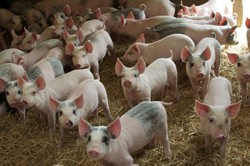A targeted approach to protect pigs from African swine fever
ASF is a highly contagious haemorrhagic viral disease of swine with mortality rates of up to 100 % in domestic pigs. Pigs can become infected by direct contact with infected swine, or indirectly by ingestion of infected meat or fomites. In areas where the soft tick vector (Ornithodoros spp.) is present in pig housing these may play a role in transmission. Although ASF occurs mostly in sub-Saharan Africa, it has recently spread in eastern Europe and is now present in three EU Member States. One major factor limiting control of the disease is the absence of an effective vaccine to protect pigs. Therefore, at present, the prevention, control and eradication of ASF is mainly based upon its early detection and the implementation of strict sanitary measures. The aim of the EU-funded ASFORCE(opens in new window) (Targeted research effort on African swine fever) project was to develop prevention and control strategies. This was achieved by designing more cost-effective surveillance and control strategies in different risk scenarios and identifying risk factors for disease spread, such as infection by wildlife. Researchers therefore contributed to understanding the patterns, causes and effects of the disease by modelling viral transmission dynamics in the wild boars' natural habitat. They also developed control and biosafety measures by studying how wild boar interacts with domestic pigs and the potential role of ticks in spreading the disease. Project partners also followed two approaches for vaccine design: the first used viral strains, modified so they don’t cause disease, to elicit protective immune responses, while the second identified viral-derived proteins that are targeted by the pig's immune system. In addition, scientists provided veterinarians, pig farmers, hunters and government agencies with information and workshops concerning surveillance and control, data for identifying risk factors and vaccine design strategies. ASFORCE results will thus help to prevent costly outbreaks, by advising stakeholders and providing policymakers with valuable decision support tools to better prevent and control ASF.







